As you certainly all know by now, any distilled agave-based spirit is a mezcal. So under the broad category of mezcal, we have a variety of spirits that are unique in their own right. Also, in the general family of agave-based alcohol, there is pulque, which is derived from the agave but is not distilled.
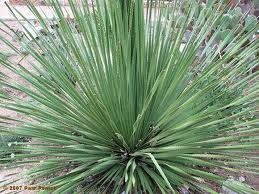
Beyond tequila and mezcal, these spirits are not widely known, though as the growth of tequila and mezcal continue, I think these spirits may slowly seep into the consciousness of agave connoisseurs. Also, as I get a fair number of questions about these agave alternatives on my blog, Twitter, or FaceBook, I thought a post on this topic would be useful to many. It actually helps me to sort it all out in my head as well. Hopefully yours too!
Before, we get into some detail, here is a basic schematic of what this world looks like.
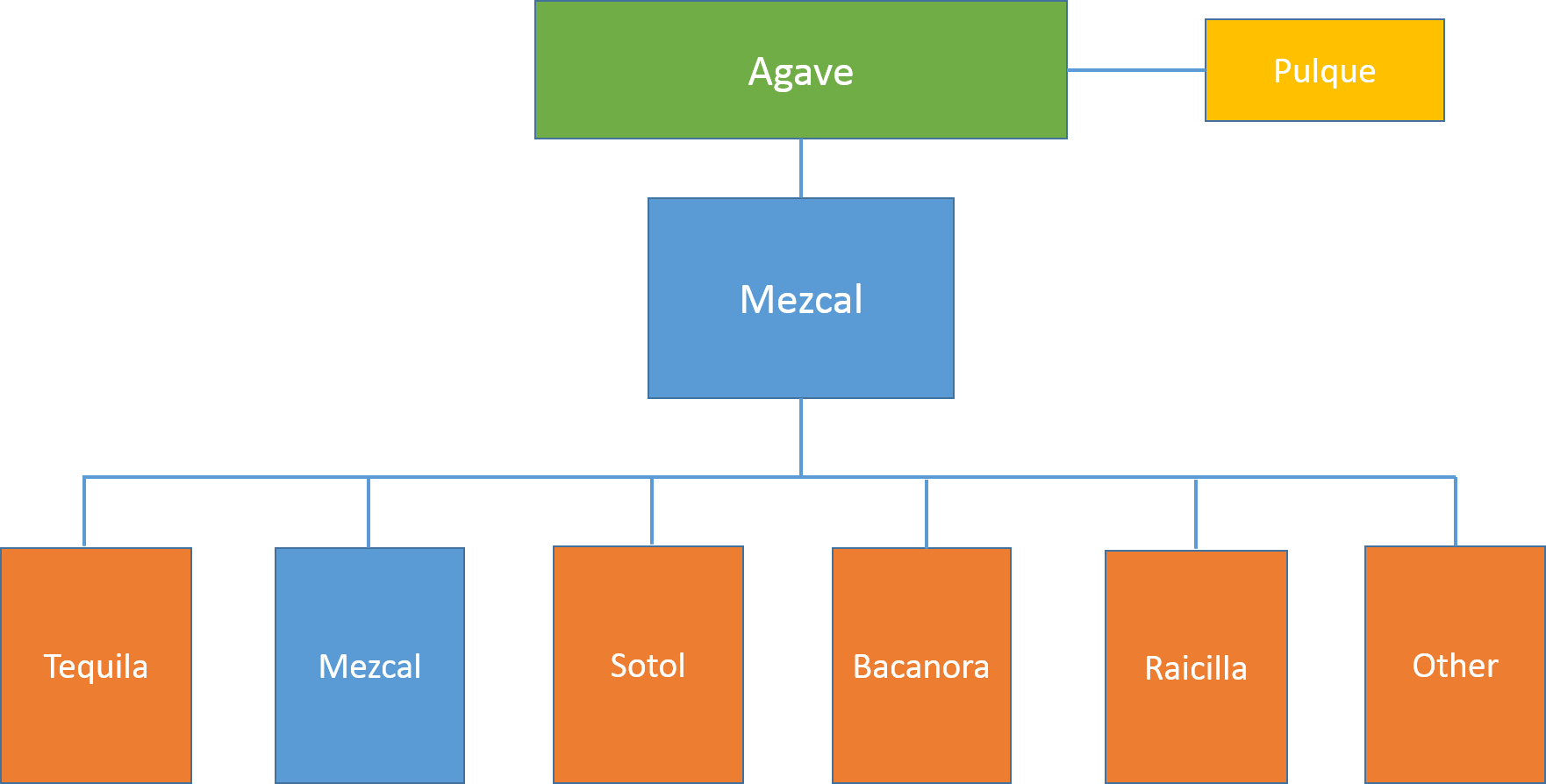 Simple, yet instructive, right?
Simple, yet instructive, right?
At the top, there is Agave (which by the way is derived from the Latin word meaning “noble” – so it belongs at the top). Directly below Agave, there is Mezcal, which is the category that envelops all spirits that are distilled from the agave plant. Then mezcal, of course, has the sub-categories below it. I also put mezcal as a sub-category of itself, because that bottom row is really how people think about the world of agave distillates.
Off to the right at the top, is Pulque. Pulque is also derived from the agave, but it is not a distilled beverage. Let’s take a look at all the categories with a handful of the distinguishing characteristics of each:
Mezcal
- Mezcal is any distilled spirit made from the agave plant
- So Tequila, Sotol, Bacanora, etc are all mezcals
- Mezcal has an internationally recognized Denomination of Origin (granted in 1995), which means that mezcal can only be made in 8 designated regions of Mexico
- Mezcal has been regulated within Mexico since 1994, and is overseen by COMERCAM, but only since 2005 has mezcal been officially certified
- Mezcal can be made from any type of agave with enough sugars to make it work
- There are roughly 40 to 50 different varieties of agave that can be used to make mezcal
- Mezcal is typically produced by baking the hearts of the agave, or pinas, in earthen pits, which imparts a smoky flavor to the mezcal
- There are somewhere around 70 mezcal brands currently being imported into the U.S.
Tequila
- Tequila can only be made from the Blue Agave (Agave tequilana), also frequently referred to as the century plant
- Tequila has an internationally recognized Denomination of Origin (granted in 1978), which means that tequila can only be made in 5 designated regions of Mexico
- The regulation process for tequila began in the 1940’s within Mexico, and the NOM has been periodically updated over the years
- Tequila is regulated within Mexico by the CRT
- Tequila can be as little as 51% agave, but all the good ones are 100% agave
- With tequila, the hearts of the agave are pressure cooked in large industrial ovens, known as autoclaves, which does not impart any special flavor characteristic to the resulting tequila
- There are something like 1,500 tequilas imported into the U.S.
Sotol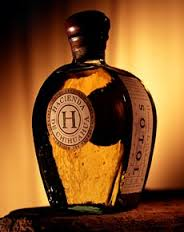
- Sotol is made from the Dasylirion wheeleri, or Desert Spoon, and it is also known as the Sotol plant. Dasylirion wheeleri is stem succulent related to yucca and agave. It was formerly in the agave family but now is classified as a member of the Nolinaceae family according to The Succulent Plant Page (and many others). So to be clear, Sotol is NOT made from an agave, therefore, not technically a mezcal. I suspect people in Mexico really could not give a crap about this technicality (“Hey Juan, can you believe this shit? They changed the freaking taxonomy!!??”), so I have kept it in this post as an agave distillate.
- Sotol has a Mexican denomination of origin, not an international DO
- Sotol received its Mexican DO in 2004
- The sotol NOM, regulating production, etc was passed on April 15, 2004
- Sotol is regulated within Mexico by the Consejo Mexicano de Sotol (formed in 2004), and can only be produced in the Northern Mexican States of Chihuahua, Coahuila, and Durango
- The few commercial sotol producers only use wild sotol plants, which take 15 years to mature.
- It generally takes one plant to produce one bottle of sotol (compared to tequila or mezcal where one plant can produce 5-10 bottles, though there are exceptions)
- The pinas are cooked in above ground ovens and distilled in column stills, so it does not have the smokiness of mezcals.
- There are only a handful of sotol brands imported into the U.S., with Hacienda de Chihuahua being the most notable
Bacanora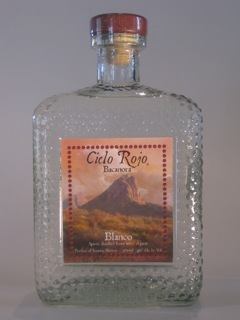
- Bacanora is produced from the wild agave Pacifica, also called agave Yaquiana (A. angustofolia), or simply bacanora, a plant that grows in the mountain range of the State of Sonora, which is the only region where bacanora can be produced
- The NOM says bacanora can only be made from Agave angustifolia
- Bacanora is a mezcal
- Bacanora is named after the town Bacanora, which is in Sonora
- Since November 6, 2000, bacanora has had a Mexican DO, but not an international one
- The bacanora NOM, regulating production, etc was passed on October 28, 2005
- Bacanora is regulated by the Consejo Sonorense Promotor de la Regulacion del Bacanora, formed in 2006
- Like mezcal, the hearts of the pina are roasted in earthen pits imparting a smoky flavor to the final product
- I only know of one bacanora brand that can be found in the U.S.: Cielo Rojo Bacanora
Raicilla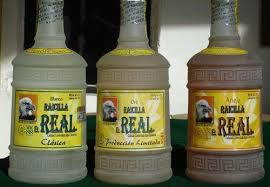
- Raicilla is produced in seven municipalities of Jalisco and is frequently associated with the Puerta Vallarta area
- Raicilla is made from the agave lechuguilla (Agave inaequidens), and agave pata de mula (Agave maximiliana), and it also goes by its regionally common name, agave raicilla
- Raicilla is a mezcal
- Raicilla does not have a DO or a NOM, however since 1997, there is a collective mark, “Raicilla Jalisco”, to protect production and establish the Mexican Council of Raicilla Promoters.
- All raicilla producers must now be members of the council and there are currently around 70 members.
- With Raicilla, the hearts of the agave are cooked in above ground ovens so it is not smoky like mezcal
- Perhaps the best known raicilla distiller is Destilador del Real, though it cannot be found in the U.S. From the picture above, I think they could use a bit of branding and marketing help. You think?
Pulque
- Pulque is not a distilled agave product, but rather a fermented alcohol product made from the sap of the agave – the sap is called aguamiel, translated as “honey water”
- Pulque is the color of milk and has a sour, yeast-like taste
- It is 3-8% ABV, so similar to beer in alcoholic content
- Pulque has no NOM or DO or anything else that I am aware of
- You can find canned pulque in the U.S., though all reports suggest it pretty much sucks
- On the other hand, in Oaxaca, you can get fresh pulque, which can be very good
- If you live in NYC, you can try it at Pulqueria, a downtown mezcal and tequila den
Others
- Sikua. Produced in Michoacán, Sikua was/is mezcal made in this state before Michoacán was included in the mezcal DO. The sikua nomenclature is most likely being left behind now since Michoacán can now officially make mezcal.
- Agave distillate. In 2006, an “agave distillate” NOM was passed to govern all mezcal making regions not recognized under a DO. So these regions can make a mezcal, but not call it one. And they are left with the appealing choice of calling it an “agave distillate”. Unjust, it seems.
- Charanda. Sometimes you hear about charanda being made in Mexico so I thought I would throw it in here. It is basically rum made in Mexico. Nothing to do with agave.
- Some other obscurities can be found here, but they are so far afield, they are not worth my effort
That is the run down. Maybe you have to be an agave geek, which I am, to care about anything beyond tequila and mezcal. But knowledge is power my friends! So go forth and drink some mezcal!!


We caught up with Alex Gilmour, General Manager of Tio’s Cerveceria in Sydney to bring you an introduction to agave spirits: Tequila, Mezcal, Raicilla, Sotol, Bacanora and Pulque.
[…] and with modern appliances), tasted different agave-based beverages, including tequila and bacanora, and saw how agave fiber can be twisted into rope and crafted into all kinds of […]
[…] main umbrella of spirits that are made from agave. Tequila is specifically from blue agave (and a subcategory of mezcal). Though not everyone is a fan of tequila (most people I know dislike it), I subscribe entirely to […]
This was so informative and useful, since I’ve been conducting virtual spirit tastings and I like to provide background information. I’m doing one on Mezcal, Bacanora, Raicilla and Sotol. Have you heard of Refino?
I have not heard of Refino? Tell me more!
Hola John. Thanks for the write up. I came across Refino in Cuernavaca in the State of Morelos. I’ve not seen it in other states in Mexico. I was told: it’s a mezcal, there are at least two producers in Morelos, and it was Zapata’s favorite drink. I’ve a bottle of it. I can send you a foto if you like.
Sounds appealing! Do you like it?
Hi John, my mistake, I just realized it was NOM 199
All good! Glad you found it.
Hi John, I enjoy your articles, interesting reads, I have a question.
You mention “Agave distillate. In 2006, an “agave distillate” NOM was passed to govern all mezcal making regions not recognized under a DO. So these regions can make a mezcal, but not call it one.”
I have been trying to find info regarding this NOM but can not find anything, can you help with more info, or direct me to a website, please?
Stay safe during these crazy times my friend.
Nice post. I think that is unfair to say what all tequila is made using autoclaves. There are good tequilas produced cooking the agave in brick ovens. Some brands even use tahonas and copper stills, at least partially. There are traditional and industrially made tequilas, just like is the case with mezcal.
You are absolutely right! There are tequila brands doing it the right way so that was an incorrect generalization on my part. I love and support brands like Fortaleza, Ocho, and Tapatio to name a few! Thanks for the correction.
Dang, I am not sure if my original comment posted. We found yet another agave distillate last night at Lanie Bayless’ Bar Sótano in Chicago. It is a beverage made in Chiapas from a mash of roasted agave and sugercane, which is then distilled. The resulting liquor has a full-bodied mouthfeel and is quite lovely. Here is a link to the bottle we tapped into last night.
https://www.oldtowntequila.com/dantano-ancestral-blanco-comiteco/
Zachary, thanks for the post. I know of comiteco but have never tried it. I did not know there was now one available in the US. I will have to check it out!
It’s called Pox (pronounced posh) & it’s made from corn, sugar cane & wheat.
No agave! I enjoy it when in San Cristobal de las Casas. Can’t find anywhere else in Mexico except for Chiapas. Mainly a ceremonial drink. It’s similar to mixing a wheated bourbon & rum together.
https://en.wikipedia.org/wiki/Pox_(drink)
It’s called Pox (pronounced posh) & it’s made from corn, sugar cane & wheat.
No agave! I enjoy it when in San Cristobal de las Casas. Can’t find anywhere else in Mexico except for Chiapas. Mainly a ceremonial drink. It’s similar to mixing a wheated bourbon & rum together.
https://en.wikipedia.org/wiki/Pox_(drink)
Hi! Thank you so much for this super informational post! I have become obsessed recently with the agave distillates, and am pouring my heart into explorations both in the US and in Mexico.
Last night, at Lanie Bayless’ Bar Sótano we were introduced to yet another version of these distillates that I did not see mentioned here, produces in Chiapas, that uses both roasted agave AND sugarcane for the mash before the distillation! The resulting liquor has a thick mouthfeel, full bodied, and slightly sweet taste, and while it is reminiscent of mezcal, it is clearly something different and special.
Here is a link to his particular brand of this liquor:
https://www.oldtowntequila.com/dantano-ancestral-blanco-comiteco/
Keep it up!
This is good information. Thank you.
Question: Wikipedia states that Sotol grows and is being produced in Texas. Is this true, and if so, by whom?
Hacienda is the only commercial producer of Sotol, as far as I know.
Thoughts?
Yes it is true. Check out https://www.desertdoor.com
Hacienda Chihuahua is industrial sotol. It is fine but tastes like tequila. There are a number of artisanal sotol brands in the U.S., including Sotol Por Siempre which I like a lot. Thanks for writing in!
Thanks for all the info folks!
Bacanora Sunora distilled from Pacifica and Bacanora Tepua also from Pacifica using an Arabic Alambic still have both made it to Colorado. Raicilla gets here in my luggage.
Dear Sir,
Thanks for a very informative piece on the alcoholic possibilities of the Agave plant.
In Jamaica, back in the 50’s and ’60’s, (until the advent of extrudable plastics), on our dry southern coastal plains, at least 2,000 acres of Agave Sisalana was cultivated.
Rope and twine were the final products.
You say there are many species of Agave that may be used in alcohol production. How would one go about determining the concentration of our local sisals in this respect ? Would it be simple process ? Any suggestions welcome.
Sincerely,
Anthony Goffe,
Mandeville,
Jamaica
Anthony, thanks for the note. I have absolutely no idea how to determine this. Sorry. I know it is based on the sugar content but I don’t know more than that. Good luck!
The sugar content is determined after cooking the cleaned up pinas, making a mash to break down the pina pulp using a tahona mill or a kitchen meat grinder or even a garbage disposal unit like people do for apple cider making and measuring the degree Brix of the clear filtered sugar solution. Same measurements are made for grape brandy from crushed grapes and sour mash Bourbon whisky. Whether you bake them over charcoal coals and buried under earth for smokiness or in a modern autoclave for 24-36 hours, the idea is break down the inulins and stored plant starches into soluble and fermentable sugars using prolonged heat and steam. Really the best way to get at what you want is to have access to a small autoclave and weigh your chopped pinas, autoclave them for a set amount of time and then ferment them for say 1 or 2 weeks. This can also be done using a kitchen pressure cooker or large pressure canner but don’t let it run dry of steam or risk a fire. If you know the starting degree Brix and the final Brix, you can determine the percent alcohol of your mash. This method avoids the unfermentable sugar contribution. Anything over 4- 5% ethyl alcohol is easily recoverable as a distillate with higher mash alcohol being obviously desirable from an industrial recovery perspective. Measuring the recovered alcohol with a small scale test distillation (eBay for lab glass etc) will give you an even more accurate measure of recoverable total alcohol yield as you can remove the heads and tails to approximate the real world yield. A one liter test pyrex glass apparatus with interchangeable ground glass joints is not so expensive and you can learn so much about what you are trying to sell by performing small scale test distillations many times over. Throw in a bubble plate to approximate a continuous column still or perform multiple pass distillation to approximate a simple Alembic still like used for Cognacs and Armagnacs and Mezcals.
Now this doesn’t begin to address taste and desirability of your distlllate as you should also be aware of methanol and higher congeners that should be carefully controlled in the fermentation (some wild yeasts make very undesirable levels of methyl alcohol and fusel oils). Also these undesirable congeners and poison alcohols can be controlled by controlling the percentage of complex carbs and sugar oligosaccharides in the cooked / digested pina’s before fermentation. Commercial Tequila production brings all the modern technologies of yeast genetics and more into play with fancy stainless steel autoclaves cycling 24-7 continuously while artisanal Mezcal producers rely on years of experience and their eyes, ears and nose to create something desirable on a much smaller single batch scale. But obviously if the Agave pina has little starch inulin to contribute, there will be no alcohols to distill and recover so that is the first step to be done before you attempt to create a new masterpiece for the world to buy. A careful measurement of alcohol yield under different growing conditions and at different life stages of the Agave is the most important info on final yield of distillate and your overall cost of production. Really, that is the heart of your process and your most important trade secret besides your craft contribution to overall aroma and taste of your distilled product.
Boom! Saved you many thousands of class fees (actually, tens of thousands as those classes are very exoensive!) at various ADI courses on craft distilling and classroom study sessions. Have you priced a brand new gleaming all polished copper still yet? Its’ the new must have accessory for the retired corporate lawyer or LBO king. Cheaper than a racing yacht but always a conversation starter. My conversation begins like this: Didja know the still is the least important part of the whole process but the most visible so always made into a big deal by new distilleries? Anyone can run a still, even moonshiners with a 3rd grade edumacation can figure it out. The important stuff all happens before you run that still and after when letting your spirits rest and mature.
Maybe for your Jamaican Mezcal, the fermentation microbes could come from an old Dunder pit yet undiscovered and filled with magic bugs and old goat heads? Or you could investigate the Okinawan Japanese methods used to produce Imo (sweet potato) Shochu. They use various saccharifying enzymes produced by molds like Aspergillus oryzae, (called koji in Japan) to break down the plant inulins and starches. It would still involve steaming the pinas but then you would inoculate the steamed pinas with a culture of said molds or Koji and let the mold enzymes do the work for you. Saves energy costs and has much higher yield of fermentable sugars. 5 thousand year old biotechnology in action. Plus unique flavor profiles are possible with many black and white Koji cultures available. And don’t forget about the many Chinese fungal enzymes used to make all those yellow and red rice wines and distilled spirits. And don’t forget to create a real bad story involving Rastafarian myths and DanceHall groups so you spirit is on every London club bar shelf at a ridiculous price. Send me a bottle when you are in production.
Wow. What an education. You and I need to get together!! Thanks!
Thank you so much for the article and after reading your article I better understand the differences between different kinds of mezcal.
Will definitely love trying different kinds of Mezcal and possibly I will be able to find a way to get Mezcal that is usually only in Mexico even though I live in America.
Thank you again for the wonderful article and all the best to you,
M
Glad you enjoyed it. There are MANY great mezcals available in the U.S.!
Ok Guys
I will clean up this mess ..
Raicilla is divided in two areas, Sierra or Costa ( coast or mountain ) .. the sierra kind is MOSTLY made from Agave Maximiliana, this is actually the one referred to raicilla commonly ( maximiliana is NOT KNOWN as pata de mula, thats another variety ), Sierra Raicillas tend to be more floral and YES they are smoky, smoke doesnt necessary comes from underground cooking process, smokiness comes from wood, adobe and volcanic rocks .. the more of those ingredients present in the cooking process the more smokiness, the most fragant, balanced and flavorfull raicillas are made in the Sierra Region in my personal opinion as costa tend to be very mineral tasting.. The costa region uses a wide variety of agaves ( weve counted around 8 ) some of most importance are orejon, verde, rodacantha etc..
THERE ARE amazing raicillas, THERE IS great branding, probably better than MOST mezcals and tequilas out there, just check out NINFA ( ninfaraicilla.com) or estancia ( estancia-raicilla.com) ..
Cheers
Great info! Thanks for adding to the post. I know of only 2 raicillas in the US (Venenosa and Estancia Raicilla). Are you aware any others?
[…] national system to classify locally made booze, called a Denominacion de Origen. Agave spirits made outside those recognized regions, such as raicilla, sotol, and bacanora, aren’t part of the […]
skimmed thru’ once before, um … after I came back from P.V. (axually’ Sigh-U-leeta) where I encountered Raicilla, only to then learn Tequila/Mezcal “wasn’t everything.” This was Feb. 2016 — tried to get Raicilla from local store — which they either wouldn’t or couldn’t get, but they had Sotol! the “top shelf” is the h.deCHIH ANEJO which I find to be eminently sip-able by itself, no ice, etc. so, i’ll try to find bacanora …
Just wanted to say “thanks” for this exposition of ALL THINGS AGAVE (distilled spirits therefrom).
I’ve been bringing Raicilla home from PV for about 10 years now. First bottle was from Juan Duenos in an Adobe hut above San Sebastian del Oeste. Many of the tourist trap “tequila factories” have it if you know to ask. Last trip I picked up a bottle of Raicilla Reposado at the Botanical Gardens, first time I’ve seen it with a tax stamp on it and the most I’ve ever paid too. Also the smokiest I’ve had. There’s still plenty of Mexican moonshine available when you get off the beaten path too.
I love your exploration! Thanks for commenting….
skimmed thru’ once before, um … after I came back from P.V. (axually’ Sigh-U-leeta) where I encountered Raicilla, only to then learn Tequila/Mezcal “wasn’t everything.” This was Feb. 2016 — tried to get Raicilla from local store — which they either wouldn’t or couldn’t get, but they had Sotol! the “top shelf” is the h.deCHIH ANEJO which I find to be eminently sip-able by itself, no ice, etc. so, i’ll try to find bacanora …
Just wanted to say “thanks” for this exposition of ALL THINGS AGAVE (distilled spirits therefrom).
[…] Mezcal, Tequila, Sotol, Bacanora, Raicilla, Pulque, and More… […]
[…] https://mezcalphd.com/2013/10/mezcal-tequila-sotol-bacanora-raicilla-pulque-and-more/ […]
Most sotoles are cooked in the ground, like mezcal. The only one that I know of that’s cooked in ovens is Hacienda de Chihuahua, which is produced like tequila.
I agree. It is an old post which could use an update! Thanks.
[…] Mezcal PhD has a really useful article and chart of agave […]